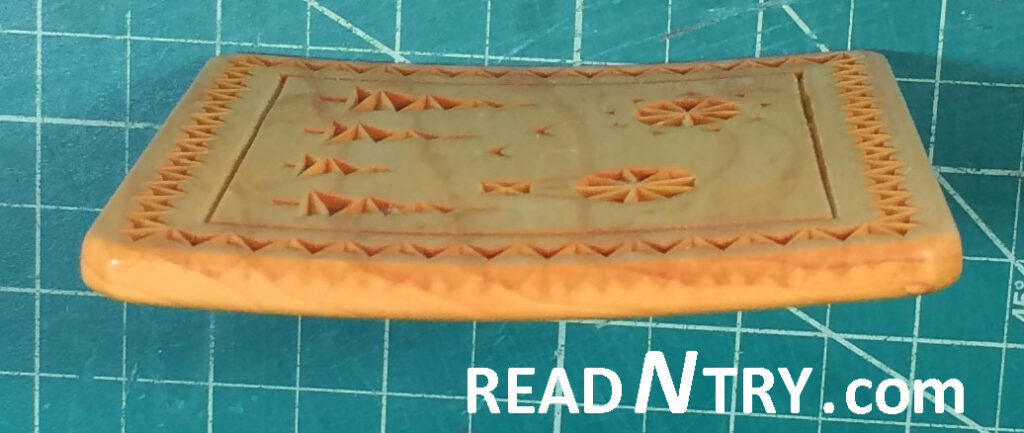Wood is natural material that sometimes moves unpredictably when moisture in the wood changes unevenly. Chip carving thin boards may release the wood internal stresses on one side of the board and that may lead to board warping, especially cupping.
Probably a half of my chip carved coasters noticeably cup as they are only 1/4″ (6 mm) thick. Let me share what I do about that issue. In most cases I don’t try making them flat as I enjoy using them as is. I like to see how my cup of tea rocks a little on a table. Of cause, it is not very convenient to use a tall wine glass with a cupped coaster. I use that pictured coaster with my morning cup of tea.

A few factors make thin boards to cup: moisture content before carving, air moisture level, sometimes heat or direct sunlight. Carving angle and chip sizes may also affect that as the air moisture may penetrate the wood from the carved side much faster.
To make the coasters straight I would suggest a few things.
Before carving:
- Pick the wood with the straight grain without any defects. Those pieces have minimal internal stresses.
- Keep the recently acquired wood near your carving place for at least 2-3 weeks before carving where humidity doesn’t change much (home), so the wood moisture level would balance with the environment (acclimatization). Some boards warp (cup or twist) during this stage.
- You may try submerging the new wood (after acclimatization) in the water for a few (5-20) seconds and let it dry before sanding and/or applying the pattern. If the board warps, it would have been definitely warped after carving. So it is better to detect the warping potential before carving.
- Carve on the side of the board that was close to the bark when it was inside the log. The reason is that the wood tends to shrink around the pith more than in the outer rings. Also wood tends to shrink around the removed chips. So, carving on the “outer” side of the board may compensate the tendency to cup “inwards”.
While carving:
- Avoid moving the wood between places with different moisture levels: living room – garage, home – wood carving club, etc.
- Keep the carving covered with a thick piece of cardboard in between carving sessions to prevent easy access of moisture from the air through the carved chips.
- Be extra careful and/or avoid using too much water or a mix of water/alcohol to fill the undercutting gaps. One drop of water may be enough to cover an undercutting mistake.
After carving:
- If the carving is still flat finish it right away. Note that finishing with oils may introduce cupping as the oils penetrate the wood and may mess with the wood a little. I finish my coasters with spray acrylic or refined walnut oil.
- If a coaster cups very little, sanding the bottom side flat is enough. Even though the carved side will not be completely flat, nobody will notice that most likely.
- If the coaster heavily warped put it under a heavy stack of books for a month or so before applying a finish. It may be flat or lightly curved after all that weight. You may even experiment and putting a coaster under books in a place where moisture changes a lot, such as garage or even outside.
I heard about this technique but have never tried it yet: wet only one side of the board and let it dry, the cupping will decrease. Repeat until the cupping disappears. Wet the right side of the board 🙂
Overall, moisture makes the wood to move… actually CHANGES in the moisture levels and temperature fluctuations make the wood to move.
All my coasters are 1/4″ thick, 3.75 x 3.75″, basswood. Thicker boards warp (cup or twist) significantly less but thinner coasters look nicer. Please visit the READ N TRY Online Store to review available boards with the coaster patterns that are ready to be carved